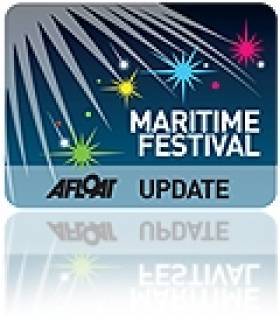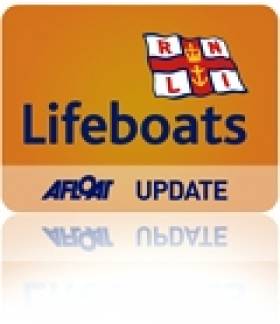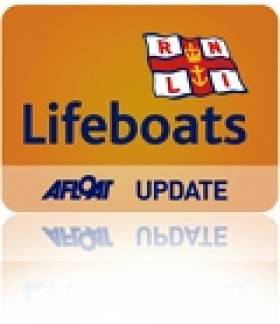Displaying items by tag: Tamarclass lifeboat
Sun, Sand and Sail at the Kilmore Quay Seafood Festival
The Kilmore Quay Seafood Festival starts this evening, now in its 42nd year, the four-day festival is surrounded by the culinary delights of locally caught fresh seafood, writes Jehan Ashmore.
In addition festival-goers can take part in the varied programme which caters for all age-groups. At 7.30pm tonight is the opening Grand Festival Parade featuring a 'Visitors From the Deep' float and Wexford's Community Samba Band 'Bloco de Fud Este'.
The festival will include a Seafood Platter Prize Competition, a children's creative art-workshop making 'Fish Kite-Windsocks', a Friday Fish Market with reduced prices and chefs cooking culinary dishes for sample-tastings and a Beach Band Barbecue.
On both the Saturday and Sunday there is the Tuskar Marine Modellors with their model boats and ships exhibition held in the Stella Maris Centre
and the Quay Times exhibition. Also throughout the weekend the Festival Arts Exhibition will be open in the RNLI Lifeboat House, noting Kilmore Quay is the first Irish lifeboat station to have the new Tamar-class lifeboat, the RNLB Killarney which can be viewed at its moorings.
On Saturday starting at 2.30pm is the "The Celtic Link Challenge" - Yacht Race when boats leave the marina at 3pm and return two hours later. The winners trophy will be presented in the Bird Rock Cafe at 6pm. If adverse weather conditions prevail the race will be re-scheduled for 2.30pm on the Sunday - weather permitting! For more information contact 086 2576862 and www.kilmorequayboatclub.com
To view the complete list of the festival programme, noting certain events and activities require an admission charge click HERE
- RNLI
- Tamarclass lifeboat
- Maritime Festivals
- Kilmore Quay Seafood Festival
- Kilmore Quay Marina
- Irish Seafood Festivals
- Stella Maris Centre
- RNLI Lifeboats
- RNLI Killarney
- Tuskar Marine Modellors
- Boat Models
- Seafood Platter
- Celtic Link ChallengeYacht Race
- Kilmore Quay Boat Club
- Fish Markets
- Beach Band Barbecue
- Celtic Link Ferries
New Tamar-Class Lifeboat: A First for RNLI in Ireland
Next month sees the introduction of the first RNLI Tamar-class lifeboat to enter service at an Irish lifeboat station, writes Jehan Ashmore.
The Tamar-class is the latest high-tech craft within the RNLI lifeboat fleet in use throughout the UK. Around 17 craft of the class, named after
the River Tamar, Cornwall have entered service. Some of the class are constructed exclusively for the purposes of providing relief duties across
the extensive network of 235 lifeboat stations throughout the UK and Ireland.
One of these relief lifeboats, RNLB Frank and Ann Wilkinson (16-06) arrived in Dun Laoghaire in July from Poole, Dorset, the headquarters of the RNLI. The lifeboat carried out crew training exercises, not just for the local lifeboat crew but other station crews as part of the Irish divisional staff training programme.
The fleet is divided into two categories: inshore and all-weather class lifeboats (ALB). Of the ALB's there are currently five classes: Tyne, Mersey, Trent, Severn and Tamar. These boats can be operated safely in all weathers and are designed to self-right in the event of a capsize.
The lifeboats are fitted with navigation, location and communication equipment with the RNLI policy of operating each craft for around 25 years. The introduction of the RNLB Killarney at Kilmore Quay will enhance the organisation's vital services off the south-east coast.
Related Safety posts
RNLI Lifeboats in Ireland
Safety News
Rescue News from RNLI Lifeboats in Ireland
Coast Guard News from Ireland
Water Safety News from Ireland
Marine Casualty Investigation Board News
Marine Warnings
Tamar-Class Lifeboat Visits Irish Waters
The Tamar-class lifeboat is the latest in a series of high-tech craft within the RNLI lifeboat fleet and in use throughout the UK. The class is named after the River Tamar, Cornwall and like other lifeboats, they are named after large rivers, writes Jehan Ashmore.
To date 17 Tamar-class boats have been commissioned for the lifesaving institution. Some of the Tamar class fleet are constructed exclusively for the purposes of providing relief-duties across the extensive network of stations. One of these relief lifeboats, RNLB Frank and Ann Wilkinson (16-06) arrived at Dun Laoghaire on 17 July. The relief Tamar's transit took two-days to reach the harbour from the RNLI's headquarters based at Poole. The lifeboat called at Plymouth for bunkers and made an overnight stay at Penlee prior to arriving at Dun Laoghaire, where another fuel-stop was undertaken.
The craft carried-out training exercises in Dublin Bay, which included a couple of trainees from the Dun Laoghaire lifeboat crew. The Tamar class lifeboat was in Irish waters primarly to cater for other station crews within the divisional staff training programme. There are no Tamar-class lifeboats operating in Irish waters, at present, though the RNLI have plans to introduce the class.

Tamar-class relief lifeboat RNLI Frank and Ann Wilkinson (16-06) nearing Dun Laoghaire. Photo © Jehan Ashmore/ShipSNAPS
Related Safety posts
RNLI Lifeboats in Ireland
Safety News
Rescue News from RNLI Lifeboats in Ireland
Coast Guard News from Ireland
Water Safety News from Ireland
Marine Casualty Investigation Board News
Marine Warnings































































